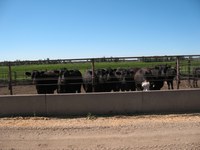23rd Annual Dakota Feeder Calf Show and Feedout Set
(Click the image below to view a high-resolution image that can be downloaded)
The 23rd annual Dakota Feeder Calf Show is planned for Saturday, Oct. 16, in Turtle Lake, N.D.
The Dakota Feeder Calf Show helps participating North Dakota cattle producers identify cattle with superior growth and carcass characteristics by offering an opportunity to measure growth performance in a feedyard. After harvest, carcass quality and value also will be determined.
Interested consignors will need to deliver 500- to 700-pound calves before 10 a.m. CST on the day of the show. Each producer can consign one or two pens containing three or four calves each. The calves are exhibited and evaluated that afternoon and then shipped to the North Dakota State University Carrington Research Extension Center (CREC) feedlot to be fed to finished market weight.
NDSU Extension partners with the Dakota Feeder Calf Show to provide producers an opportunity to experience retained ownership of calves beyond the cow-calf segment of cattle production.
“There are several ways to collect growth performance carcass data from your calves,” says Karl Hoppe, Extension livestock systems specialist at the CREC. “The best is to feed out your entire calf crop. That takes considerable time, effort and funds. An alternative is to consign a group of calves to a feedout project. Your risk is less and a feedout project provides a substantial amount of information about the calves.”
Dakota Feeder Calf Show chairman Darwin Chesrown has been consigning calves since the feedout started.
“I enjoy comparing my weaned calves in October to the finished calves in May,” he says. “The calves really grow and I do see differences in herd sires.”
During the 2020‐21 feedout, the calves gained an average of 772 pounds in 222 days, with a total feeding cost (excluding interest) of 82.9 cents per pound of gain. The average sale weight was 1,374 pounds. The calves were fed with a market weight break‐even point of $111.74 per hundredweight.
"It's the variation among cattle that makes this project educational and a real eye‐opener," Hoppe says.
In the 2020‐21 feedout, the spread in net return per head between the average of the top and bottom five herds was $189.02. The spread between the top and bottom herd is more noticeable ($276.93 per head). Average daily weight gain in the feedlot was 3.85 pounds for the top‐profiting herd and 3.04 pounds for the bottom herd.
"Small differences in production have a huge impact on profit," Hoppe says.
Feedout project staff will gather data on the rate of gain, feeding costs and other characteristics during the trial. After the calves are marketed, the staff will collect and provide information to the entrants on carcass weight, meat quality and value.
Calves should be prevaccinated for BVD, PI3, IBR and BRSV, Mannheimia, Clostridials and histophilus somni. Booster vaccinations will be administered upon delivery to the show.
Producers will be assessed an entry fee of $20 per calf. Dakota Feeder Calf Show officials will present awards to producers at the end of the trial.
For more information or to preregister calves, contact Hoppe at the CREC at 701‐652‐2951, by cell at 701-650-8810 or karl.hoppe@ndsu.edu, or Chesrown, Dakota Feeder Calf Show Committee, at 701‐448‐9286.
NDSU Agriculture Communication – Sept. 17, 2021
Source; Karl Hoppe, 701‐652‐2951, karl.hoppe@ndsu.edu
Editor: Kelli Anderson, 701-231-6136, kelli.c.anderson@ndsu.edu


